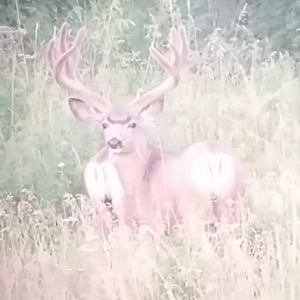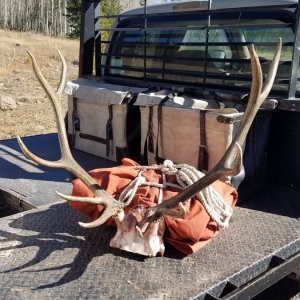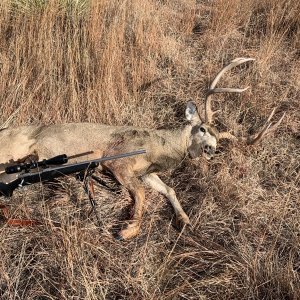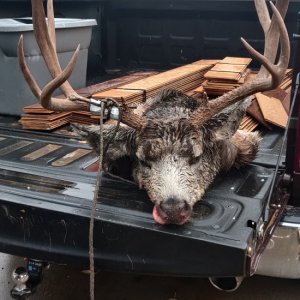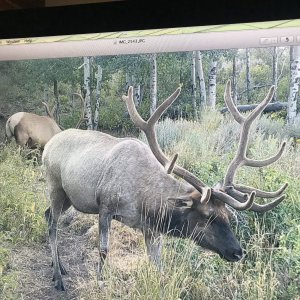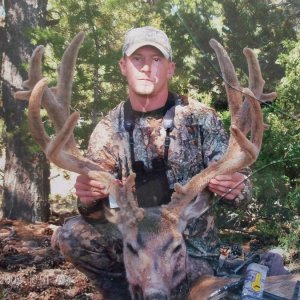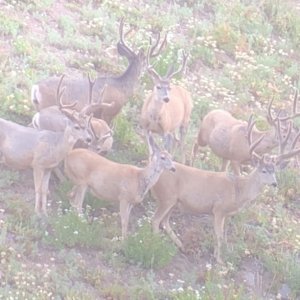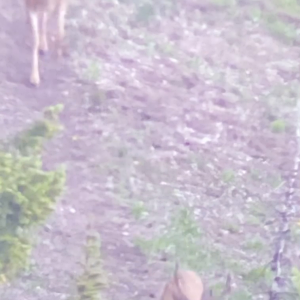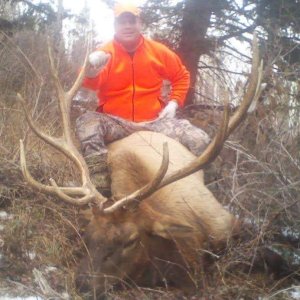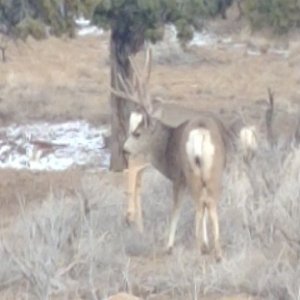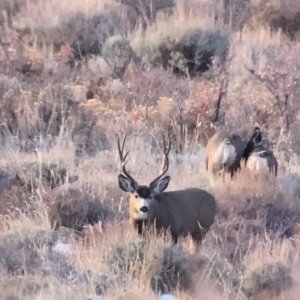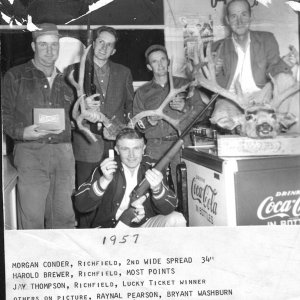>nebo12000:
>
>Just a quesiton:
>
>You are the representative for the
>sportsman of the Central Region.
> You represent if not
>the largest number of sportsman,
>then the second largest group
>of sportsman in the State
>of Utah. Many of
>these sportsman travel outside of
>the region to hunt.
>If you focus only on
>Central Region units and issues,
>are you representing the sportsman
>of the Central Region in
>an effective manner.
>
>That is just a question, not
>an accusation.
>
>You might not be the local
>expert, but you are the
>voice for Central Region sportsman.
>
>
>I would prefer that our local
>reps worked with the other
>local reps to provide a
>wide range of opportuinities.
>With 30 units I would
>think that if they talked
>and work together, rather than
>focusing solely on their own
>backyards we will all benefit.
>
>
>We are all in this together,
>it is not a regional
>problem and we need a
>statewide solution.
GREAT points, BlueGoat. I've hunted in every region of our state multiple times and I think hunting multiple regions is more common than not amongst deer hunters.
Here's an excerpt from a study done in Colorado on cutting buck harvest vs. fawn recruitment. It's log, but useful in the context of this conversation.
Effect of limited antlered harvest on mule deer sex and age ratios
Chad J. Bishop, Gary C. White, David J. Freddy, and Bruce E. Watkins
Abstract
Key words
In response to apparent declining mule deer (Odocoileus hemionus) numbers in Colorado during the 1990s, buck harvest limitations were identified as a possible mech- anism to increase fawn:doe ratios and hence population productivity. Beginning in 1991, the Colorado Division of Wildlife (CDOW) reduced buck harvest in 4 deer management units to provide quality hunting opportunities. We examined effects of limited harvest on December ratios of bucks:100 does and fawns:100 does using data from limited and unlimited harvest units. Annual buck harvest was reduced by 359 bucks (SE = 133) in limited harvest units as a result of limiting licenses. Fawn:doe ratios declined by 7.51 fawns:100 does (SE = 2.50), total buck:doe ratios increased by 4.52 bucks:100 does (SE = 1.40), and adult buck:doe ratios increased by 3.37 bucks:100 does (SE = 1.04) in response to limited harvest.
Based on our analysis, factors other than buck harvest were regulating population productivity, and limiting buck harvest to enhance fawn recruit- ment is not justified in Colorado. Limited buck harvest should be considered an issue of quality hunting opportunity rather than deer productivity.
age ratio, buck:doe ratio, Colorado, fawn:doe ratio, limited harvest, mule deer, Odocoileus hemionus, productivity, quality hunting, sex ratio
Declining December fawn:doe ratios of mule deer (Odocoileus hemionus) in Colorado during 1975?1995 were hypothesized as being caused by a coincident decline in buck:doe ratios. White et al. (2001) concluded that the effect of buck:doe ratios on subsequent fawn:doe ratios was not adequate to explain the downward trend in population produc- tivity. Other studies also failed to demonstrate a strong relationship between sex ratios and age ratios the following year (Haywood et al. 1987, Horejsi et al. 1988, McCulloch and Smith 1991). Regardless, segments of the hunting public have expounded on the importance of maintaining rela- tively high buck:doe ratios (e.g., 25 bucks:100 does post-harvest) to assure reproductive success. Two interrelated questions subsequently arose: whether fawn production and survival could be increased by limiting buck harvest, and whether factors other than mature buck:doe ratios were affecting popula-
tion productivity. Increasing mature male:female ratios could optimize timing and reduce duration of rut, increase pregnancy rates, and perhaps enhance fitness of offspring because more mature males would be available for breeding and ungulate social systems would be more natural (Bubenik 1985, Ozoga and Verme 1985, Noyes et al. 1996, Noyes et al. 2002). If factors such as habitat quality, disease, weather events, or predation were limiting produc- tivity, then higher mature male:female ratios should have little effect on fawn production and survival.
Decisions to limit buck harvest generally are based on 2 main objectives: provide quality hunting oppor- tunity for older age-class animals and/or increase pop- ulation productivity.
Reduced buck harvest generally leads to increased buck:doe ratios and an older age structure of bucks in a population but does not nec- essarily equate to enhanced productivity. We define quality as reduced hunting pressure, increased hunter
Address for Chad J. Bishop and Bruce E. Watkins: Colorado Division of Wildlife, 2300 South Townsend Avenue, Montrose, CO 81401, USA; present address for Bishop: 317 West Prospect Road, Fort Collins, CO 80526, USA; e-mail:
[email protected]. Address for Gary C. White: Department of Fishery and Wildlife Biology, Colorado State University, Fort Collins, CO 80523, USA. Address for David J. Freddy: Colorado Division of Wildlife, 317 West Prospect Road, Fort Collins, CO 80526, USA.
Wildlife Society Bulletin 2005, 33(2):662?668 Peer refereed
Effect of limited harvest on deer ratios ? Bishop et al. 663
success, and increased numbers of older bucks in the harvest. Management for quality harvest opportuni- ties is based primarily upon social and economic considerations, and has been successful on private, tribal, and public lands when local community sup- port was obtained. Conversely, limiting buck harvest to enhance productivity should address some identi- fiable biological issue. Deer managers should clearly distinguish between these 2 management objectives concerning buck harvest to avoid confusion among hunters and the public.
Past research has demonstrated that some hunters do not consider harvest or size of buck harvested to be major factors affecting their overall hunt satisfaction (Potter et al. 1973, Brown et al. 1977, Decker et al. 1980, Langenau et al. 1981). In 1991, 87% of surveyed Colorado deer hunters expressed satisfaction with harvesting any deer, whether male or female, and these hunters also expressed a desire to manage only 20% of the mule deer hunting opportunity for limited harvest (Freddy et al. 1993). Similarly, in a 1999 survey, only 17% of Colorado deer hunters desired a manage- ment system that maximized trophy hunting, and a majority preferred management for maximum hunting opportunity to avoid constraints on partic- ipation (Fix et al. 2001). However, Colorado hunters and other wildlife enthusiasts appear to be supportive of harvest limitations and therefore reduced hunting opportunity if such restrictions are needed to increase deer population productivi- ty (Malmsbury 1999). Assessing whether limiting harvest of adult males improves fawn production and survival is needed for management decisions that affect hunter participation.
Colorado Division of Wildlife (CDOW) restricted buck harvest in 4 management units in western Colorado during the early 1990s to manage a por- tion of the mule deer resource for quality hunting opportunity. Unlimited harvest was maintained in all other management units in the mountainous region of Colorado through 1998. In 1999 CDOW limited buck harvest in all units, primarily to increase population productivity. The level of har- vest reductions varied by unit, depending on public comment, but were less restrictive than those implemented in the 4 quality harvest management units. Here we evaluate buck:doe and fawn:doe ratios between quality harvest and unlimited har- vest units from 1983 through 1998 to assess whether harvest reductions implemented in 1999 were likely to increase population productivity.
Study area
Colorado has been divided into 54 data analysis units (DAUs) to manage mule deer hunting, with each DAU comprising >1 game management unit (GMU). A DAU is the smallest spatial unit at which a population or herd can be defined, although some interchange of deer occurs between adjacent DAUs throughout the state. Also, management pre- scriptions sometimes vary among GMUs within DAUs. Prior to 1999 DAU D-19 consisted of 1 GMU (61) managed as a limited buck harvest unit and a second GMU (62) managed as an unlimited buck harvest unit. For our analysis we treated these GMUs as 2 separate DAUs (D-61 and D-62). We included D-61 in the analysis because no DAU rep- resented a closed population, D-61 was larger than some DAUs, and the purpose of our analysis was to evaluate limited buck harvest as it was implement- ed by CDOW.
We conducted our analyses on DAUs west of Interstate 25, which encompassed the mountain- ous portion of Colorado and contained most of the state?s mule deer. The 4 DAUs with limited buck harvest were D-3, D-6, D-14, and D-61. Limited buck harvest was not implemented simultaneously in the 4 DAUs but began in 1991 in D-6, 1992 in D- 14 and D-61, and 1995 in D-3. Unlimited buck hunting existed in all other DAUs during 1983?1998 (Figure 1).
Figure 1. Location of mule deer data analysis units (DAUs) west of Interstate 25 in Colorado. Shaded DAUs (D-3, D-6, D-14, D- 61) received limited buck harvest treatments during the early 1990s. Non-shaded DAUs did not receive harvest treatments and were managed for unlimited buck harvest. DAUs east of Interstate 25 were excluded because they comprise plains habi- tats with low mule deer densities and were managed different- ly from intermountain DAUs.
664 Wildlife Society Bulletin 2005, 33(2):662?668
Limited buck hunting DAUs represented the diversity of Colorado?s mule deer habitats. Winter ranges varied from high-elevation sagebrush (Artemisia tridentata) parks to low-elevation piny- on?juniper (Pinus edulis?Juniperus osteosper- ma). Summer-range habitats included alpine, conifer?meadow (Pinus contorta, Picea engel- mannii), spruce?subalpine fir (Picea spp.?Abies lasiocarpa), aspen (Populus tremuloides), oak- brush (Quercus gambelii), and ponderosa pine (Pinus ponderosa). In relative terms winters were cold in D-3, moderate in D-6 and D-14, and mild in D-61. Average snowfall was greater in D-3 and D-14 than in D-6 and D-61.
Methods
Harvest surveys
Harvest surveys were performed annually using a questionnaire mailing (1983?1987) or telephone survey (1988?1998) (White 1993, Steinert et al. 1994). Sample-size calculations were based on α = 0.05 and an assumed success ratio of 0.50. On aver- age, 30% of hunters were randomly sampled in each limited harvest DAU where the number of license holders was known. An average of 27% of hunters statewide were randomly sampled to estimate har- vest in unlimited DAUs.
Age- and sex-ratio surveys
Helicopter surveys to measure post-harvest age and sex ratios in DAUs were performed during December or early January. Most of the data were collected by flying nonrandom routes in areas known to be inhabited by deer and classifying all animals encountered. Deer were classified as fawns, does (antlerless), or bucks (antlered). Bucks were further classified as yearling or adult based on antler size and number of points. Total buck:doe, adult buck:doe, and fawn:doe ratios were calculat- ed for each DAU and entered into the CDOW statewide Deer, Elk, and Antelope Management (DEAMAN) database.
We used data from 270 post-harvest ratio surveys in 23 of the 44 DAUs west of Interstate 25. Each DAU in the analysis had >8 surveys,and each survey comprised >1 helicopter flights and <40 hours of helicopter time. Mean number of deer classified per DAU survey was 2,011 (SD = 1,661, min = 297, max = 12,201). Surveys met the sample-size crite- rion of 500 animals proposed by Czaplewski et al. (1983) 97% of the time.
Statistical methods
We used PROC MIXED in SAS (Littell et al. 1996, SAS Institute Inc. 1997) to measure the effect of lim- ited licenses on buck harvest. This analysis was necessary because harvest across all DAUs declined during the 1990s, and the analysis isolated the por- tion of harvest declines attributable to limited licenses. Number of males harvested was the dependent variable, and harvest treatment (limited buck harvest vs. unlimited buck harvest), DAU, and year were the independent variables in a mixed model. Harvest treatment and DAU were treated as fixed effects and year as a random effect. The year variance component was estimated using the max- imum likelihood method (ML).
We then used PROC MIXED (Littell et al. 1996) to determine what effect reduced buck harvest had on age and sex ratios. Observed fawn:doe, total buck:doe, and adult buck:doe ratios were depend- ent variables in a mixed model, with year treated as a random effect, and DAU, harvest treatment (limit- ed vs. unlimited buck harvest), and number of har- vested females >14 months old treated as fixed effects. Female harvest declined after buck harvest was limited in 3 of the treatment DAUs and was included in the model to correct the observed post- harvest ratios for number of females harvested. We incorporated staggered entry of treatment DAUs into the analysis by assigning 1 = limited and 2 = unlimited to each DAU each year. Thus, the treat- ment variable was 2 for each DAU each year until
Figure 2. Mule deer buck harvest from 1983?1998 in data analysis units (DAUs) in Colorado where limited harvest treat- ments were implemented during the early 1990s. The black marker (?) indicates when limited harvest was initiated in each DAU.
Effect of limited harvest on deer ratios ? Bishop et al. 665
Figure 3. Raw means of the observed (A) total buck:doe ratios and (B) fawn:doe ratios in treatment and control mule deer data analysis units (DAUs) during 1983?1998 in Colorado. Treat- ment DAUs switched from unlimited harvest to limited harvest during the early 1990s; control DAUs were managed for unlim- ited harvest during all years shown. Harvest was limited in DAU D-6 in 1991 (?), in DAU D-14 and D-61 in 1992 (?), and in DAU D-3 in 1995 (?). limited licenses were implemented, at which point the value was changed to 1 for each subsequent year. The year variance component was again esti- mated via ML. There was no autocorrelation struc- ture in the model across years because DAU was considered a fixed effect and there was only 1 observation per year per DAU.
Selection of the appropriate fixed-effects model structure for the number of females harvested was made with Akaike?s Information Criterion (AICc) corrected for sample size. Akaike weights were used to evaluate the strength of evidence for each competing model, and parameter estimates were calculated using model averaging (Burnham and Anderson 2002).
Results
Mean annual buck harvest in treatment DAUs declined from 788 (SE = 59) bucks pretreatment to 209 (SE = 27) bucks post-treatment (Figure 2), while mean hunter numbers dropped from 3,277 (SE = 222) to 653 (SE = 140). Observed total buck:doe ratios steadily increased in treatment DAUs following implementation of limited harvest, whereas observed fawn:doe ratios did not consis- tently increase (Figure 3).
Reduction in annual buck harvest attributable solely to the harvest treatment was 359 bucks (SE = 133). For analyses evaluating effect of reduced buck harvest on fawn:doe ratios, the best AICc model included DAU and treatment but not female harvest, although some Akaike weight was associated with the model that included female harvest. The best AICc model for determining effect of the treatment on buck:doe ratios included female harvest, yet some Akaike weight was associated with the simpler model that excluded female harvest (Table 1).
We therefore used model averaging to estimate the effect of the treatment on fawn:doe and buck:doe ratios. In response to limited buck harvest, fawn:doe ratios declined by 7.51 fawns:100 does (SE = 2.50), while total buck:doe ratios increased by 4.52 bucks:100 does (SE = 1.40) and adult buck:doe ratios increased by 3.37 bucks:100 does (SE = 1.04) (Tables 1 and 2).[u/]
http://unitedwildlifecooperative.org

